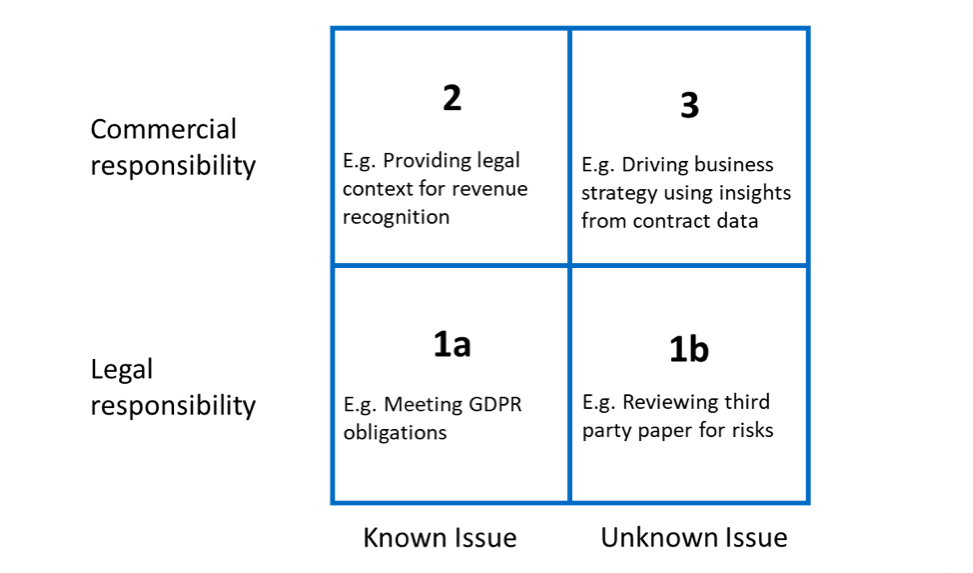
You Are Sitting On a Data Gold Mine. Go Dig!
By Martin Davidson, Chief Legal Officer of legal AI company, ThoughtRiver.
As lawyers, there is always the imperative to offer value to commercial colleagues or clients. With the advance of technology there are now increasing opportunities for lawyers to elevate the service they provide by considering the value of data sitting in the contracts sitting right under their nose. In doing so, they can offer real value to the CFOs and CEOs they support.
Corporate counsel have traditionally had two functions:
– Advising executives on legal and regulatory risk; and
– Creating, negotiating and reviewing documents to ensure they optimise the corporate’s commercial position and adhere to legal and regulatory obligations.

In recent years, there has been increasing pressure in most industries on lawyers to deliver more for less money. The net result is that lawyer time – even at relatively senior levels – is monopolised on delivery of these basic essentials. This means less time for these highly educated and capable individuals on exercising genuine legal judgement to support the strategic imperative of the businesses they support, to the detriment of the lawyer and their employers.
New technology is beginning to attack this problem from both ends. First, it is making it possible for the lawyer to automate more of the basic tasks. At the same time it provides powerful insights into future performance.
What if a lawyer can offer value beyond this, for example:
– Offering counsel to executives on commercial and strategic issues
– Providing insight into the opportunities and risk that reside within legal documents.
Technology is now a key enabler in helping lawyers to achieve this without the need for additional resource.
Importance of legal context to commercial data
Most modern businesses utilize various tools to collect commercial data and present them in a structured format. This data includes purchase costs, revenues, supplier/consumer information, etc. Conventional wisdom dictates that good business decisions should always be data-driven, and most effective businesses do rely heavily on the insights derived from commercial data to strategize.

Most executives and lawyers do not realise that many commercial problems or obligations can be addressed by lawyers adding valuable legal context. This is illustrated by Figure 1 below.
Currently, most lawyers operate in quadrants 1a & 1b. Incursions into quadrants 2 and 3 are only motivated by the lawyer’s business experience and rarely backed by insights obtained from analysing legal data.
Until recently, the effort required to manually construct any meaningful structure of data from unstructured documents such as contracts and agreements far outweighs the potential insights that can be obtained. However, that is no longer the case as lawyers can use a combination of AI tools and intelligent schema to efficiently crunch large volumes of legal data from various documents.

Applications of Legal Data
Quadrants 1a & 1b:
In recent years, lawyers have started employing various tools to automate work that traditionally falls under their responsibility. AI tools can be taught exactly what they should be looking for; they can then trawl through large volumes of unstructured data quickly to present them in a structured format. This makes them extremely useful for meeting obligatory requirements, such as those set out within the GDPR, where large volumes of unstructured documents need to be reviewed. The best tools allow data to be summarized with internal integrity and coherence.
This ‘intelligent schema’ allows the AI to possess a sophisticated understanding of meaning behind summarized data by establishing hierarchies of relationship between data fields. The same principles apply for contract drafting and review. For instance, legal teams can harness legal data to determine which liabilities are the riskiest or which combination of provisions results in the most optimal commercial outcome.
Quadrant 2:
Executives face many business challenges that they do not realise their legal teams can help them solve. For example, CEOs and CFOs make decisions based on revenue forecast numbers using commercial data. However, most types of commercial data collected does not present the legal context around which revenue can be recognized.
Currently, this risk of not recognizing revenue is determined anecdotally; this is inadequate for a thorough risk assessment. Legal teams can use the tools they are already familiar with in the bottom quadrants and train them to look for the legal context around important commercial issues such as this. The hierarchy of meaning provided by the intelligent schema offers an objective and quantitative summary that is free from potentially confounding variables.
Quadrant 3:
A business is the sum of all contractual obligations to suppliers and customers. Once lawyers have used AI tools to obtain, analyse and organize data from contractual documents, that data can be queried to obtain legal and commercial insights. Not many executives would expect their legal teams to possess the richest trove of commercial data to draw the most complete insights from. For example, a CFO/CEO might expect to run into liquidity issues in the foreseeable future.
A legal counsel could utilize an AI tool that understands accounts payable and accounts receivable as a set of relationships between payment terms, rights to terminate, break fees etc. to determine precisely how liquid their contracts are and also the relative performance of debtors as against their contracted payment terms enabling CFOs/CEOs to make better informed decisions. Legal data also allows for better governance by offering visibility into what is being contracted and how. Legal teams can flag up risks and anomalies to their CEO for them to meet their governance obligations.
These are just some examples of how lawyers can go above and beyond their current responsibilities through the application of AI. Ultimately, lawyers need to realise they are sitting on a gold mine of data. It is up to their wits, with canny application of technology, to create and deliver that additional value. So what are you waiting for, go dig!
This is a Sponsored Thought Leadership article by ThoughtRiver, the legal AI contract analysis company.